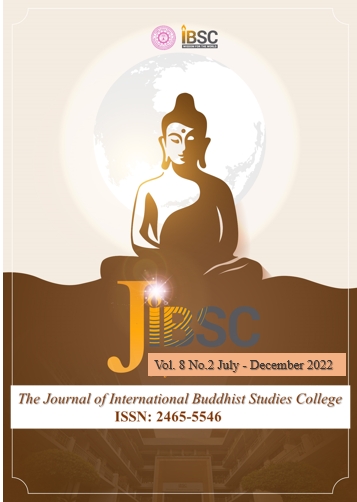A Comparative Study of the Foundations of Mindfulness (satipaṭṭhāna) Teachings between Theravāda and Tibetan Vajrayāna Buddhism
Main Article Content
Abstract
This article aims to compare and analyze the teachings of the foundations of mindfulness (satipaṭṭhāna) between Theravāda and Tibetan Vajrayāna Buddhism. The findings reveal two main similarities in both concept and practice. Firstly, the terms smṛti or sati are similarly defined as ‘mindfulness’ or ‘remembrance’. Both traditions share the ultimate goal of attaining the highest peace (nirvāṇa) by realizing the three characteristics. Secondly, the practice is categorized into four areas: observation of the body, feelings, mind, and phenomena. However, there are notable differences in how these foundations of mindfulness are applied. In the Pāli canon, the sequence of observing the body begins with the breathing section, whereas in Vajrayāna, it starts with bodily postures. Additionally, the Pāli canon divides the observation of mind-objects into five detailed categories. In contrast, the Tibetan canon does not explicitly list these five categories, though many Sanskrit and Tibetan commentaries provide detailed explanations.
Article Details
The Journal of TCI is licensed under a Creative Commons Attribution-NonCommercial-NoDerivatives 4.0 International (CC BY-NC-ND 4.0) licence unless otherwise stated. Please read our Policies page for more information on Open Access, copyright and permissions.
References
Akira, Hirakawa. A History of Indian Buddhism from Śākyamuni to Early Mahāyāna, trans. Paul Groner. USA: University of Hawaii Press, 1990.
Anālayo Bhikkhu. Buddhist Foundation of Mindfulness, Mindfulness in Behavioral Health. Switzerland: Spring International Publishing, 2015.
Anālayo Bhikkhu. Satipaṭṭhāna: The Direct Path to Realization. Malaysia: Buddhist Wisdom Centre, 2006.
Bhikkhu Bodhi. “What Does Mindfulness Really Mean?” Contemporary Buddhism: An Interdisciplinary Journal. Vol. 12 No.1 (2011): 19-39.
Bodhi, Bhikkhu (trans.). Saṃyutta Nikāya [The Connected Discourses of the Buddha]. Vol 1. Oxford: PTS., 2000.
Buddhaghosa, Bhadantācariya. Visuddhimagga: The Path of Purification. Translated by Bhikkhu Ñānamoli. 4th Edition. Sri Lanka: Buddhist Publication Society, 2010.
Daśa¬sāhasrikā¬prajñā¬pāramitā [The Transcendent Perfection of Wisdom in Ten Thousand Lines]. https://read.84000.co/translation/toh11.html#UT22084-031-002-949 (accessed February 24, 2021).
Debvedi Prayudh Payutto, Phra. Sammāsati: An Exposition of Right Mindfulness. Translated by Dhamma Vijaya. Bangkok, Thailand: Buddhadhama Foundation, 1988.
Henepola Gunaratana, Bhante. Mindfulness in Plain English. Boston: Wisdom Publications, 2012.
Lama, Dalai. and Jinpa, Thupten. Science and Philosophy in the Indian Buddhist Classics: The Mind. Vol. 2. Translated by Dechen Richard and John D. Dunne. New York: Wisdom Publications, 2020.
Lay, U Ko. Manual of Vipassana Meditation, 1st Edition. Maharashtra, India: Vipassana Research Institute, 2002.
Mahatthanadull, Sanu, and Mahatthanadull, Sarita. “Holistic Well-beings Promotion for Balanced Way of Life according to Buddhist Psychology”, JIBSC, Vol. 6 No. 1 (January-June 2020).
Mahatthanadull, Sanu. “Concepts and Principles of Buddhism 625 102”. Teaching Document. Buddhist Studies Program. 2nd Edition. Ayutthaya. Mahachulalongkornrajavidyalaya University Press, 2020.
Mahatthanadull, Sanu. “The Art of Breathing: Buddhist Principle and Methods”. Commemorative Book. The 2nd MCU International Academic Conference. Bangkok. JPrint Mahadhat. (May 19, 2016).
Ñānamoli, Bhikkhu and Bodhi, Bhikkhu (trans.). Majjhima-nikāya [The Middle Length Discourses of the Buddha]. Oxford: PTS., 2001.
Rhys Davids, Caroline A F (trans.). Dhamma-Sångni: A Buddhist Manual of Psychological Ethics. 2nd Edition. London: The Royal Asiatic Society, 1923.
Rochard, Dechen and Dunne, John D. (trans.). Aṣṭādaśasāhasrikā Prajñāpāramitā [The Perfection of Wisdom Sūtra in Eighteen Thousand Lines]. Somerville, MA: Wisdom Publications, 2020.
Sujato Bhikkhu. A History of Mindfulness: How Insight Worsted Tranquility in the Satipaṭṭhāna Sutta. Taiwan: The Corporate Body of the Buddha Education Foundation, 2005.
T.W and Rhys Davids, C A F (trans.). Dīgha-nikāya [Dialogues of the Buddha]. Vol. 3. Part. 2. Delhi: Low Price Publications, 2001.
Tibetan-Sanskrit-English Dictionary. USA: UMA Institute for Tibetan Studies, 2016.
Tsong Khapa, Je. Lamrim Chenmo: The Great Treatise on the Stages of the Path to Enlightenment. Translated by the Lamrim Cheno Translation Committee. Vol. 1 &2. 1st Edition. New York: Ithaca, Snow Lion Publication, 2000.
Vasubandhu, Ācārya. Abhidharmakośabhāsyam. Translated by Leo M. Pruden. Vol. 3. Berkeley: Asian Humanities Press, 1991.
Walshe, Maurice (trans.). Dīgha Nikāya [The long discourse of the Buddha]. Vol. 2. London: Wisdom Publication, 1987.
Winzer, Lylla., Samutachak, Bhubate., and Gray, Rossarin Soottipong. “Religiosity, Spirituality, and Happiness in Thailand from the Perspective of Buddhism,” Journal of Population and Social Studies 26, no. 4 (2018): 334-5. https://doi.org/10.25133/ JPSSv26n4.023.


